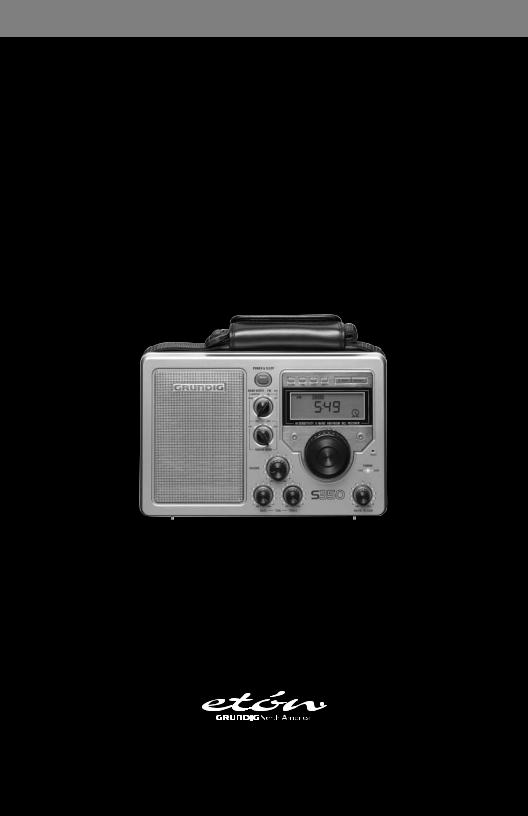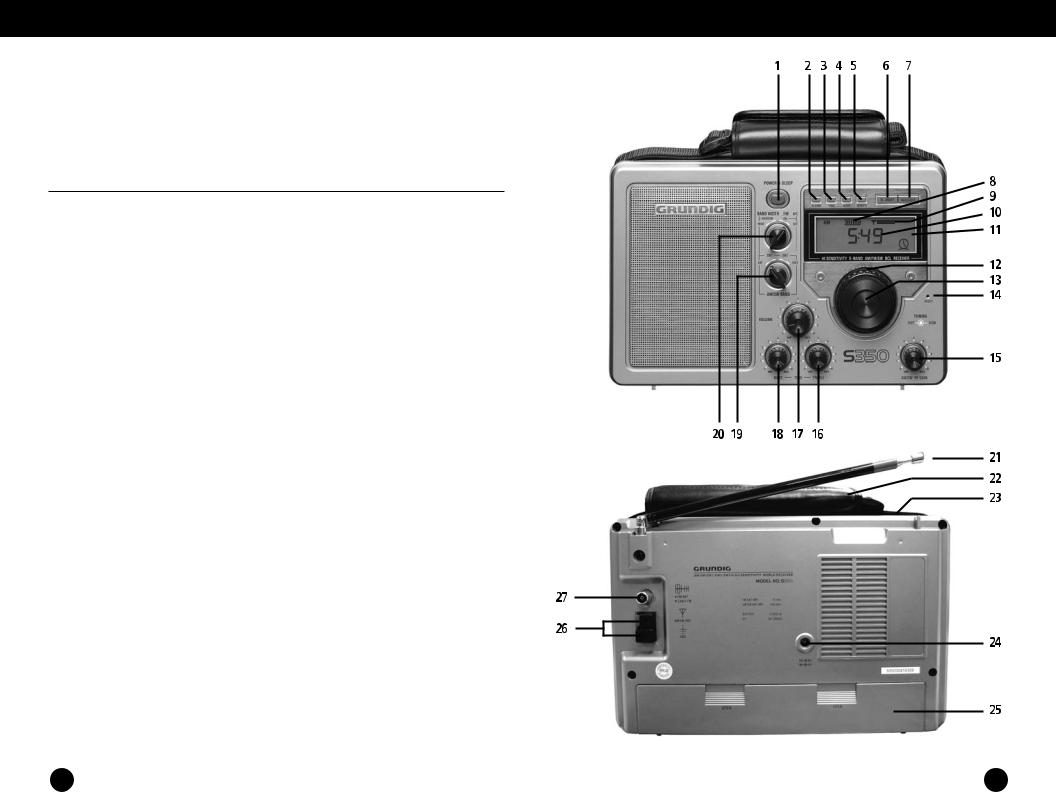Grundig S-350 Owners Manual

w w w . e t o n c o r p . c o m
S 3 5 0
O P E R AT I O N M A N U A L
A M / F M / S H O R T W AV E R A D I O

S 3 5 0 O P E R AT I O N M A N U A L
TABLE OF CONTENTS
NEED HELP? HERE’S HOW
TO CONTACT US:
•From the United States: (800) 872-2228
•From Canada: (800) 637-1648
•From Everywhere Else: (650) 903-3866
•Email: customersvc@etoncorp.com
•Internet: www.etoncorp.com
|
|
page |
1 |
INTRODUCTION ...................................................................... |
4 |
2 |
MAJOR FEATURES OF THE MODEL S350 .............................. |
5 |
3 |
CONTROL LOCATIONS .............................................................. |
6 |
4 |
CONNECTING TO POWER ....................................................... |
8 |
5 |
PRELIMINARY CONTROL SETTINGS ........................................ |
10 |
6 |
TURNING THE RADIO ON AND OFF ....................................... |
11 |
7 |
SIGNAL STRENGTH INDICATOR ............................................... |
11 |
8 |
TUNING IN FM STATIONS ....................................................... |
12 |
9 |
TUNING IN AM STATIONS ....................................................... |
12 |
10 |
TUNING IN SHORTWAVE STATIONS ......................................... |
13 |
11 |
SETTING THE CLOCK ............................................................. |
15 |
12 |
USING THE SLEEP TIMER ..................................................... |
15 |
13 |
ALARM CLOCK .......................................................................... |
16 |
14 |
USING THE BACKLIGHT ....................................................... |
17 |
15 |
USING THE RESET ................................................................. |
17 |
16 |
USING THE LINE OUT SOCKETS ........................................... |
18 |
17 |
USING THE EARPHONE JACK ................................................ |
18 |
18 |
USING SUPPLEMENTARY ANTENNAS .................................. |
19 |
19 |
INTRODUCTION TO SHORTWAVE ........................................ |
20 |
20 |
FINDING DESIRED STATIONS ............................................... |
20 |
21 |
WHAT ARE BANDS? .............................................................. |
21 |
22 |
SHORTWAVE BANDS ............................................................. |
22 |
23 |
DAY BANDS / NIGHT BANDS ................................................. |
23 |
24 |
DAYTIME LISTENING ........................................................... |
24 |
25 |
EVENING LISTENING .............................................................. |
25 |
26 |
SERVICE INFORMATION .............................................................. |
26 |
27 |
ONE YEAR LIMITED WARRANTY ................................................ |
26 |
2 |
3 |

S 3 5 0 O P E R AT I O N M A N U A L
1 INTRODUCTION |
|
2 MAJOR FEATURES OF THE MODEL S350 |
This owner's manual is conveniently divided into two sections, BASIC OPERATION and INTRODUCTION TO SHORTWAVE. Both sections are important.
If you are new to shortwave listening, the INTRODUCTION TO SHORTWAVE section will give you all the information that you need to be successful enjoying broadcasts from around the world.
•AM 530-1710 KHz
•FM 88-108 MHz
•SHORTWAVE – continuous coverage from 3 to 28 MHz. This includes 13 international broadcast bands. 11, 13, 15, 16, 19, 22, 25, 31, 41, 49, 60, 75 and 90 meters.
•Highly sensitive and selective analog tuner circuitry
•Digital frequency readout
•Liquid Crystal Display, (LCD), for frequency and clock
•Digital clock with selectable 12/24 hour format
•Wake-up timer (use as radio-play alarm clock)
•Power failure backup feature
•Sleep timer
•Main tuning knob and independent finetuning control knob
•Variable RF Gain Control
•Rotary volume control
•Variable, independent bass and treble controls
•Low-pass filter for shortwave and AM reception
•Left/Right line level outputs (stereo in FM)
•Stereo/Mono switch
•Earphone socket
•Carrying handle/convertible shoulder strap
•Built-in telescopic antenna for FM and shortwave
•Built-in ferrite bar antenna for AM
•Jacks for supplementary AM, FM and Shortwave antennas
•Powered by 4 D cell batteries (not included), AC adaptor (included) or DC car or boat adaptor (not included)
IMPORTANT NOTE: While using the owner’s manual, refer to the diagram titled CONTROL LOCATIONS to locate controls, switches, sockets, and parts that are referred to in the text.
4 |
5 |

S 3 5 0 O P E R AT I O N M A N U A L
3 CONTROL LOCATION
1 Power & Sleep Button
2 Alarm Set Button
3 Time Set Button
4 Hour Set Button
5 Minute Set Button
6 Alarm On/Off Button
7 Backlight Button
8 Battery Power Indicator
9 Signal/Strength Indicator
10 Digital Frequency Readout
11 LCD Display
12 Turning Knob (fast)
13 Turning Knob (slow)
14 Reset Button
15 MW/SW RF Gain Knob
16 Treble Knob
17 Volume Knob
18 Bass Knob
19 MW/SW1/SW2/SW3 Band Select
20 Bandwidth/FM Band Select
21 Telescopic Antenna for FM/SW
22 Carrying Handle
23 Shoulder Strap
24 DC Jack
25 Battery Compartment
26 MW/SW Antenna Jack
27 FM Antenna Jack
6 |
7 |

S 3 5 0 O P E R AT I O N M A N U A L
4 CONNECTING TO POWER
USING BATTERIES
Open the battery compartment and insert 4 size D batteries (also called UM-1) according to the polarity diagram imprinted on the battery compartment floor.
Please note the following regarding battery operation:
•The S-350 has a battery power indicator in the LCD. Fresh batteries will show a full power level of six bars. If the indicator shows less than two bars or the sound becomes week and distorted, replace the batteries.
•The radio will turn off automatically if the
batteries become too weak.
•Check the batteries periodically for leakage. As a precaution, remove the batteries to prevent possible leakage if it is to be stored for long periods without use.
•Turn off the radio while replacing the batteries.
USING AC POWER
The S350 is supplied with an AC adaptor that converts AC voltage to the DC voltage used by the radio. Only use the adaptor that is supplied with the S350 or one that meets the generic specifications required by this product: output of 6 volts, DC, negative polarity; plug-tip outer diame-
ter of 5.5 millimeter, inner diameter of 2.1 millimeter; capable of 300 milliamperes or greater. Contact Etón for the name and location of a retailer that sells the proper adaptor.
NEVER USE AN ADAPTOR THAT DOES NOT MEET THESE SPECIFICATIONS, AS IT MAY CAUSE DAMAGE NOT COVERED BY WARRANTY.
POWERING FROM A CAR OR
BOAT 12 VOLT DC BATTERY
SOURCE
This requires a DC converter that converts the 12 volt DC source to the 6 volts required by the radio. The output of such an adaptor is 6 volts, DC, negative polarity. The plug-tip must have an outer diameter of 5.5 millimeter and an inner
diameter of 2.1 millimeter.
The plug-tip is plugged into the radio’s DC jack. It must be capable of handling at least 200 milliamperes of current. Contact Etón for the name and location of a retailer that sells the proper converter.
8 |
9 |

S 3 5 0 O P E R AT I O N M A N U A L
5 SETTING THE PRELIMINARY CONTROL SETTINGS
Use these controls as initial guidelines. As you get to know the radio, you will develop your own ‘favorite’ settings.
•Turn the VOLUME control down to no
greater than 3 so that the radio does not play loudly when first turned on.
•Turn the AM/SW RF GAIN control to the 10 position.
•Turn the BASS-TONE-TREBLE controls into the 5 position.
•Turn the SW LPF switch to the OFF position (right side of the radio).
•Turn the STEREO MONO switch to the MONO position.
6 TURNING THE RADIO ON AND OFF
There are two ways to turn the radio on, with the 90-minute timer feature or without the 90-minute timer. To turn it off at any time, press the ‘POWER & SLEEP’ button.
NOTE: When SLEEP Times is off, the clock always shows in the display.
1.WITH TIMER: A quick, short press of the ‘POWER & SLEEP’ button turns the radio on. ‘90’ shows in the display for about three seconds, then the radio’s normal frequency display shows. Turning it on this way causes it play for 90 minutes, after which its timer turns
it off automatically (to minimize excess battery drain). To change this automatic turn-off time from 90 minutes to a shorter time, see the section titled USING THE SLEEP TIMER.
2.WITHOUT TIMER: A long press of approximately 3 seconds of the ‘POWER & SLEEP’ button turns the radio on without engaging the automatic 90-minute timer feature, causing the radio to play indefinitely when using the AC adaptor, and turning off only when the batteries drain or the radio is turned off.
7 SIGNAL STRENGTH INDICATOR
When you are listening to stations, the signal strength meter, in the upper right area of the display, will show the strength level of reception.
10 |
11 |

S 3 5 0 O P E R AT I O N M A N U A L
8 TUNING IN FM STATIONS
Fully extend the telescopic antenna and turn on the radio. Switch the BAND WIDTH FM AFC selector to the FM AFC ON position. FM appears in the display, as well as FM frequency numbers in the range of about 87-108 megahertz, abbreviated MHz. Use the outer ‘fast’ tuning knob to find stations, fine tuning with the inner ‘slow’ knob when needed. When Automatic Frequency Control (AFC) is ON, strong signals will automatically be captured and given precedence over weaker ones. With AFC turned OFF, the weak stations inbetween stronger ones will be tuned in easier. AFC ON is generally the preferred position.
•Placing the STEREO MONO switch in the STEREO position enables FM reception in stereo.
NOTE: The stereo is not heard from earphones or headphones; it is only heard from the stereo line-level outputs when feeding their output to amplified speakers or a stereo system.
•Placing the STEREO MONO switch in the MONO position will improve the quality of a poorly received station, but it will not be heard in stereophonic sound from the line level outputs.
•When listening through the built-in speaker, stereophonic sound is not heard. Only monaural sound is heard from the built-in speaker.
•If a station is not being received clearly, swiveling the telescopic antenna may result in improved reception.
9 TUNING IN AM STATIONS
TUNING IN AM STATIONS (MW)
Turn on the radio and turn the AM/SW BAND switch to the AM position. MW appears in the display. Use the outer ‘fast’ tuning knob to find stations, fine tuning with the inner ‘slow’ knob when needed.
•If there is interference from adjacent
stations, place the BAND WIDTH control in the NARROW position. If there is no interference, leave it in the WIDE position.
•If there is excess background noise, turn on the SW LPF switch, which may minimize the noise.
•If a station is so strong that audio distortion occurs, reduce the gain level with the AM/SW RF GAIN control knob by turning it counterclockwise.
•The telescopic antenna does not have to be extended for AM reception. The radio has an internal, directional, ferrite-bar antenna for AM reception.
•To optimize AM reception, swivel the radio until maximum signal strength is achieved.
12 |
13 |

S 3 5 0 O P E R AT I O N M A N U A L
10 TUNING IN SHORTWAVE STATIONS
IF YOU ARE ALREADY FAMIL-
IAR WITH SHORTWAVE:
Fully extend the telescopic antenna and turn on the radio. Turn the AM/SW BAND switch to the SW1, SW2 or SW3 position. SHORTWAVE 1, 2 or 3 appears in the display. Use the outer ‘fast’
tuning knob to quickly go to a desired frequency that you already know or to the band that you want to tune around in, then fine tune stations with the inner ‘slow’ knob when needed. If a station is so strong that audio distortion occurs, reduce the gain level with the AM/SW RF
GAIN control knob by turning it counter-clock- wise.
IF YOU ARE NEW TO SHORT-
WAVE OR NEED A REFRESHER
(also see the section titled INTRODUCTION TO SHORTWAVE, later in this manual) Fully extend the telescopic antenna and turn on the radio.
Get close to a window and fully extend the telescopic antenna. Follow the instructions below, depending on day or night listening.
If it is daytime, turn the AM/SW BAND switch to the SW2 position. Use the fast tuning knob and tune to 15100 KHz. This is the beginning of the shortwave 19 meter band, one of the three best daytime bands, extending from 15100-15600
KHz. Using the slow tuning knob, tune through this band, carefully listening for stations.
Also try the 13 meter band (21450-21850 KHz) and 16 meter band (17480-17900 KHz), both in SW3.
If it is night, turn the AM/SW BAND switch to the SW1 position. Use the fast tuning knob and tune to 5800 KHz. This is the beginning of the shortwave 49 meter band, one of the four best night bands, extending from 5800-6200 KHz. Using the slow tuning knob, tune through this band, carefully listening for stations. Also try the 25 meter band in SW2 (11600-12200 KHz), 31 meters in SW2 (9400-9900 KHz) and 41 meters in SW1 (7150-7600 KHz).
NOTE: If there is interference from adjacent stations, place the BAND WIDTH control in the NARROW position. If there is no interference, leave it in the WIDE position. If there is excess background noise, turn on the SW LPF switch, which may minimize the noise. If a station is so strong that audio distortion occurs, reduce the gain level with the AM/SW RF GAIN control knob by turning it counter-clockwise.
11 SETTING THE CLOCK
The S350's clock is a selectable 12-hour AM/PM mode or 24-hour mode time system. Pressing the HOUR button for more than five seconds toggles it from one mode to the other. When AM or PM appears in the display, it is set in the 12-hour AM/PM mode. If they are not in the display, it is in the 24-hour mode.
The radio must be turned off to set the clock. With the radio turned off, hold down the TIME button for three seconds, then release it. The time display will flash. While it is flashing press the HOUR and MINUTE buttons to set the correct time. After setting the correct time, immediately press the TIME button to finalize the entry. If the TIME button is not pressed, the display will automatically finalize the entry after about five sec-
onds. While setting the time, the HOUR and MINUTE buttons can be held down to advance the time faster.
NOTE: When the radio is turned off, the display panel shows the time. When it is turned on, it shows a radio frequency. While on, pressing the TIME button causes the display to change from frequency to time for about three seconds, after which it shows frequency again.
POWER FAILURE BACKUP
FEATURE
If batteries are in the S350 and it is powered via its AC adaptor, it will automatically switch to battery use if there is an AC power failure.
12 USING THE SLEEP TIMER
The S350 includes a sleep timer, which lets you set the radio to turn off after an amount of time of your choice. On the S350, the sleep timer is automatically activated for 90 minutes whenever the radio is turned on. After pressing the POWER&SLEEP button to turn on the radio, notice that ‘90’ appears in the display. This means that the radio’s sleep timer is engaged, allowing the radio to automatically turn off after 90 minutes.
To change the amount of minutes that the radio plays before automatically shutting off, press the POWER&SLEEP button to switch on the radio.
After 90 appears, immediately do quick, short, repeated presses on the POWER & SLEEP button until the desired time is reached. Note that the sleep timer changes from 90 to 75 to 60 to 45 to30 to15 to10 to 01 minutes and finally to off, with each successive press.
14 |
15 |

S 3 5 0 O P E R AT I O N M A N U A L
13 ALARM CLOCK
SETTING, ACTIVATING AND
DEACTIVATING (ALARM
CLOCK)
The S350 includes a programmable turn-on timer, which allows it to turn on at preset times, like an alarm clock. With the radio powered off, hold down the ALARM button for about three seconds or until the time digits start flashing, then release it. While they are still flashing press the HOUR and MINUTE buttons to set the turn-on time, then immediately press the AL ARM button. If the ALARM button is not pressed, the turn-on time will automatically be set at the time you selected after 5 seconds.
To activate/deactivate the turn-on timer feature, with the radio turned off, press the AL ON/OFF button, causing the symbol of a speaker to appear in the upper right corner of the display. When the speaker symbol is in the display, the
turn-on timer feature is activated. When it is not in the display, it is deactivated.
To see the turn-on time at any time, with the radio on or off, press the ALARM button. The turnon time will then appear in the display for about four seconds.
IMPORTANT NOTES ABOUT THE
TURN-ON TIMER FEATURE
•The radio must be turned off for the turn-on timer feature to function.
•The radio will automatically turn off after playing for 30 minutes.
•To turn off the radio before it turns off automatically, press the AL ON/OFF or POWER&SLEEP button.
14 USING THE BACKLIGHT
The S350 has a backlight to light the display in low light situations. It can be activated with the following two methods.
1.To temporarily light the display, perform a quick, short press on the BACKLIGHT button. The backlight automatically turns off after eight seconds.
15 USING THE RESET
2.To permanently light the display, press and hold BACKLIGHT button for more than one second. The backlight will be turned on until the BACKLIGHT button is pressed again.
CAUTION: leaving the backlight permanently on will drain the batteries more rapidly.
S350 incorporates with a computer microchip (the component that controls how the radio operates). If the radio has been subjected to abnormal environmental conditions, the computer microchip may malfunction and the following symptoms may appear.
•The display shows nothing and the radio cannot be turned on by pressing POWER & SLEEP button.
•The display shows random characters or
does not work properly although the radio
can receive stations normally.
In these cases, you might need to reset the radio. To reset the S350, unplug the external adaptor (if one is being used) and remove the batteries from the battery compartment. Insert a pointed object, such as straightened paper clip, into the RESET hole on the right, front side of the radio and gently press and release the button inside the hole. Then plug in the AC adaptor or reinstall the batteries.
16 |
17 |

S 3 5 0 O P E R AT I O N M A N U A L
16 USING THE LINE OUT SOCKETS
The line out sockets (RCA sockets), labeled L, R, |
with audio line level inputs. The output is stereo |
provide industry standard left and right stereo |
when the radio is tuned to an FM station broad- |
line level outputs that can be used to feed audio |
casting in stereo. |
to a tape recorder, stereo system, or any device |
|
17 USING THE EARPHONE JACK
The earphone jack can be used with stereo or mono earphones or headphones using a 1/8 inch (3.5 millimeter) plug. Sound is monaural.
18 USING SUPPLEMENTARY ANTENNAS
SHORTWAVE ANTENNAS. This radio can be used with basic, long wire antennas and other high impedance shortwave antennas (optimally 500 ohm). The length of a long-wire antenna should be anywhere from about 30-100 feet (1030 meters). Best performance is from copper wire. The antenna should be above ground, preferably running in a straight line. Non-conductive insulators should be used on both ends of the wire to prevent signal loss. The wire is plugged into the red colored spring socket, AM,SW
ANT., on the back of the radio. Connecting a ground wire to the black spring socket, GND, often helps reception, but is not mandatory. The ground wire should be connected to a cold water pipe or a ground rod. If no water pipe or ground rod is available, connect a wire about the same length as the antenna wire and lay it on the ground. NEVER CONNECT THE GROUND WIRE TO A GAS PIPE.
AM ANTENNAS: Any high impedance (optimally 500 ohm) AM antenna can be used, including long-wires and tuned loops. A ground wire, as discussed under SHORTWAVE ANTENNAS, is even more helpful during AM reception and often improves reception considerably, even when no supplementary AM antenna is used.
FM ANTENNAS: Connect FM antennas to the FM ANT. CABLE FM socket on the back of the radio. These antennas should have an impedance of 75 ohms. Most antennas fed with coaxial cable are 75 ohm antennas. If your coaxial cable has a ‘F’ plug, like that used on North American TV’s and VCR’s, use a F to PAL converter plug to fit the European style PAL socket on the radio. (Radio Shack part number 278-265).
18 |
19 |

S 3 5 0 O P E R AT I O N M A N U A L
19 INTRODUCTION TO SHORTWAVE
Shortwave enables you to hear stations from around the world. Now that you have a shortwave radio, no doubt you’ll want to hear worldwide stations right away. If you’re new to shortwave, please take some time to learn the basics outlined below. To successfully listen to shortwave stations you must know how to find
them. They are found in the shortwave ‘bands’. If you’re an experienced shortwave listener, you’ll already know what bands are and how to use them, but if you’re new, you’ll need to learn about bands first. After that, you will have excellent success. Please read on.
20 FINDING DESIRED STATIONS
HOW TO IDENTIFY WHAT YOU’RE LISTENING TO AND HOW TO FIND STATIONS THAT YOU WANT TO HEAR
We recommend the use of a comprehensive shortwave directory, especially if you want to hear specific countries or to identify the station you’re listening to. Such a directory will alphabetically list the countries broadcasting on shortwave, showing their language, target area, broadcast
time, and frequency that is used. The best shortwave directory is PASSPORT TO WORLD BAND RADIO, available in major bookstores. Published by International Broadcasting Services, Ltd., Box 300, Penn's Park, Pennsylvania 18943 or available at www.passband.com. This publication has separate chapters for English and non-English broadcasts, titled World-Wide Broadcasts In English and Voices From Home.
21 WHAT ARE BANDS?
TO FULLY ENJOY SHORTWAVE
LISTENING, THIS IS THE MOST
IMPORTANT CONCEPT TO
LEARN RIGHT AWAY.
If you have ever listened to AM or FM radio, then you already know what a band is. The AM band is a frequency range stretching form 530 to 1600 kilohertz, the FM band is 88-108 megahertz. A band is simply a frequency range where stations are located. When you look for stations in these ‘bands’, you simply tune around with the tuning knob until you find a station you like. Shortwave is similar and the shortwave bands have names like 25 meters, 31 meters, 49 meters, etc. These
are abbreviated 25m, 31m and 49m. Just like in AM and FM radio, one simply gets into the shortwave band and tunes around, looking for stations.
For example, the 19 meter shortwave band encompasses the frequency range of 15100 to 15600 kilohertz. On the next page is a list of the shortwave bands used for international shortwave broadcasts and their corresponding frequency ranges. Since some radios show frequency in megahertz and some in kilohertz, both are shown here. The S350 shows shortwave frequencies in kilohertz, abbreviated KHz.
20 |
21 |

S 3 5 0 O P E R AT I O N M A N U A L
22 SHORTWAVE BANDS
BAND |
MEGAHERTZ (MHz) |
KILOHERTZ (KHz) |
S350 |
|
(as on some radios) |
(as on the model S350) |
switch setting |
|
|
|
|
120 meters |
2,300-2,500 MHz |
23002500 KHz |
SW1 |
|
|
|
|
90 meters |
3,20-3,40 MHz |
3200-3400 KHz |
SW1 |
75 meters |
3,90-4,00 MHz |
3900-4000 KHz |
SW1 |
|
|
|
|
60 meters |
4,750-5,060 MHz |
4750-5060 KHz |
SW1 |
49 meters |
5,950-6,20 MHz |
5950-6200 KHz |
SW1 |
|
|
|
|
41 meters |
7,10-7,60 MHz |
7100-7600 KHz |
SW1 |
31 meters |
9,20-9,90 MHz |
9500-9900 KHz |
SW2 |
|
|
|
|
25 meters |
11,600-12,200 MHz |
11600-12100 KHz |
SW2 |
22 meters |
13,570-13,870 MHz |
13570-13870 KHz |
SW2 |
|
|
|
|
19 meters |
15,10-15,80 MHz |
15100-15800 KHz |
SW2 |
16 meters |
17,480-17,90 MHz |
17480-17900 KHz |
SW3 |
|
|
|
|
13 meters |
21,450-21,850 MHz |
21450-21850 KHz |
SW3 |
11 meters |
25,60-26,10 MHz |
25600-26100 KHz |
SW3 |
|
|
|
|
10 meters |
26,965-27,41 MHz |
26965-27410 KHz |
SW3 |
|
|
|
|
also called ’citizens band’ or CB
23 DAY BANDS / NIGHT BANDS
DAY BANDS / NIGHT BANDS –
THE DIFFERENCE IS VERY IMPOR-
TANT
Because shortwave signals depend on such factors as the sun, the ionosphere and interaction with the earth itself, signals cannot be heard on all bands throughout the day. Some bands are best during the daylight hours, and some are best at night. Here are some good ‘rules of thumb’.
•In general, the bands with frequencies below 13000 KHz are better at night and the bands with frequencies above 13000 KHz are best during the day. This guideline is not ‘cast in concrete’ but is a useful general rule of thumb.
•Around sunrise and sunset, both the day and night bands might be good, sometimes exceptionally good.
•In the summer time, the day bands often are good into the early night.
•While most shortwave stations are found within the frequency limits of these defined bands, some are found outside of them. It pays to take the time to tune in-between bands too.
•These guidelines can be used worldwide and are not dependent on location.
Listed on the next page are the characteristics of the major shortwave bands. Follow these guidelines for best listening results.
22 |
23 |

S 3 5 0 O P E R AT I O N M A N U A L
24 DAYTIME LISTENING
Shortwave listening is generally at its poorest during the daylight hours of about two hours after sunrise until about two hours before sunset. The major reason for this is that the broadcasters are not transmitting to North America at this time, assuming that we are all either at work or at school and are not able to listen during the day. If you want to try daytime listening, use the guidelines below. Typically, daytime shortwave tends to be better in Eastern North America than in Western North America.
DAY BANDS |
CHARACTERISTICS |
13meters |
Results vary. Worth trying. Sometimes extremely good around sunrise and sunset. |
|
|
16meters |
Similar to 19m. |
19meters |
The best overall daytime band. May also be good at night in the summer months. |
|
Sometimes extremely good around sunrise and sunset. Sometimes good at night in the |
|
summer. |
|
|
22meters |
Similar to 19m. |
|
|
25 EVENING/NIGHT LISTENING
This is the best time to listen, because the broadcasters are deliberately transmitting to North America. These
bands may be extremely good around sunset and sunrise too.
NIGHT BANDS |
CHARACTERISTICS |
|
|
25 meters |
Similar to 31m. |
|
|
31 meters |
Good all night, everywhere. Often extremely good at sunrise and sunset. Good results |
|
|
|
often start about an hour before sunset. |
|
|
41 meters |
Similar to 49m. Good all night in Eastern North America; varies in Western North |
|
America. |
49 meters |
The best overall night band. |
|
|
IMPORTANT NOTE: Getting close to a window may substantially improve your reception. The construction materials of some buildings simply do not let signals in very well. Signals penetrate wood frame buildings easiest, while concrete and brick buildings usually block signals. If you are in a building with one or more stories above you, signals can also be impaired in strength. In such a situation, situate the radio as close to a window as possible while listening. Holding the radio while close to a window may also improve reception.
24 |
25 |
